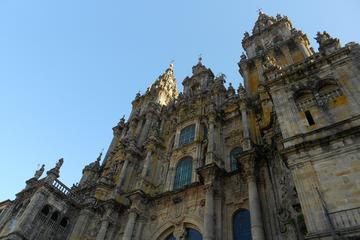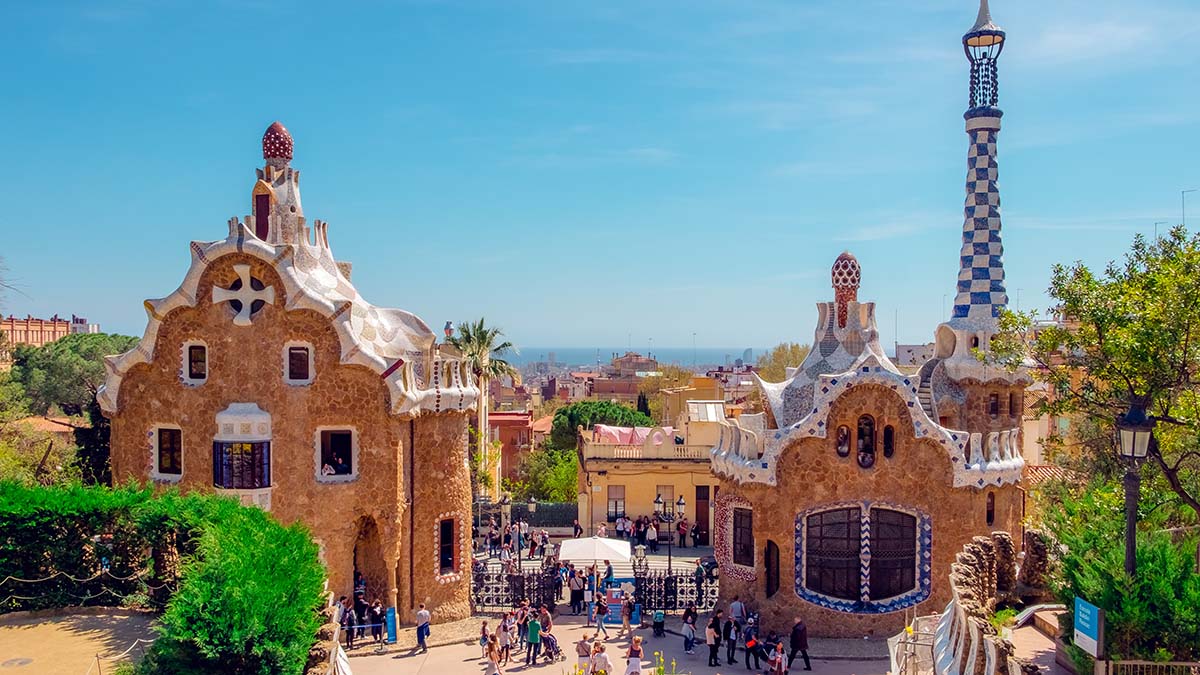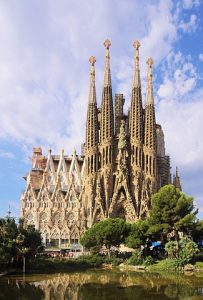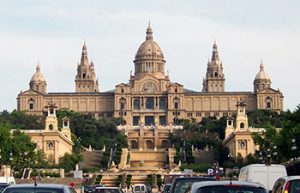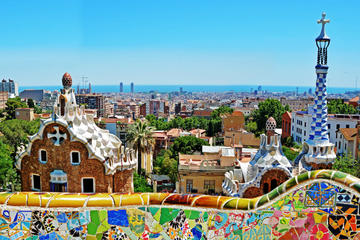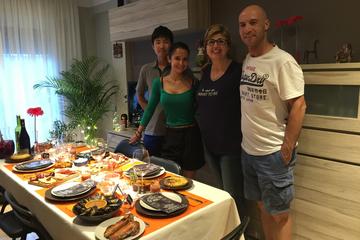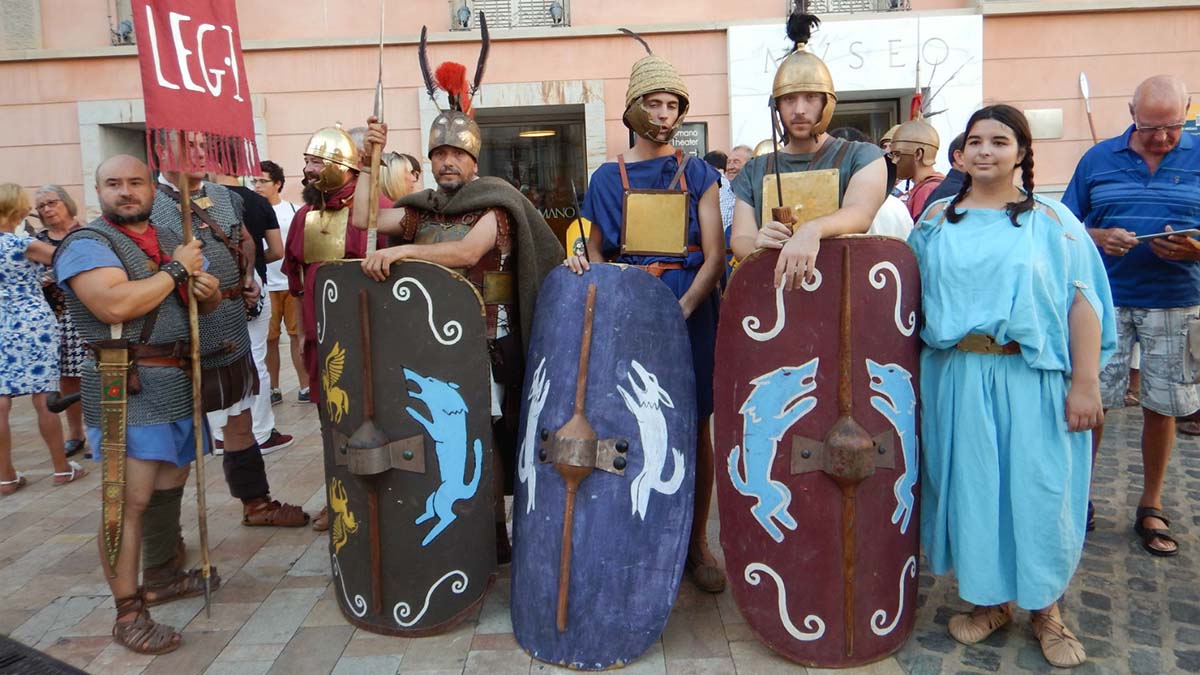
by Darlene Foster
The ground shakes with the ominous beat of drums. Passing by us are legions of solemn Roman soldiers, animal-skin clad barbarians with painted faces and colourful shields, ferocious gladiators wearing appropriate sandals, dancing maidens, priests, soothsayers and toga covered senators. We find ourselves in the midst of a Romans and Carthaginians Festival. This spectacle is held every year to celebrate the vibrant history of the strategic port city of Cartagena, Spain.
Cartagena has more than 2,000 years of history. The Romans and Carthaginians Festival is a remembrance of the second Punic War, beginning with the foundation of Qart Hadast, the name given to Cartagena by the Phoenicians in 228 BC, and ending with its capture by the Romans in 209 BC. The Romans named the city Carthago Nova (the New Carthage)
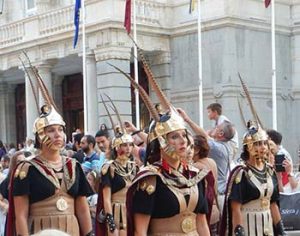 Throughout the last ten days of September, battles are re-enacted, ancient ceremonies held and troops in full battle dress march through the streets of Cartagena. The Carthaginian and Roman armies arrive by sea in a dramatic display and then march through town to an encampment set up on the football field. We are fortunate to witness part of this event during an enchanting evening I will never forget.
Throughout the last ten days of September, battles are re-enacted, ancient ceremonies held and troops in full battle dress march through the streets of Cartagena. The Carthaginian and Roman armies arrive by sea in a dramatic display and then march through town to an encampment set up on the football field. We are fortunate to witness part of this event during an enchanting evening I will never forget.
The costumes and attention to historic detail are amazing. It is as if all the citizens of Cartagena are in costume for the event. And like everything in Spain, the entire family is involved. Men, woman and children take on roles as Roman soldiers and barbarian hordes. The tradesfolk who followed the armies serving their needs are also represented. Bakers, butchers, blacksmiths, potters and entertainers are interspersed between armies following standard bearers. Elaborate floats depicting Roman villas and amphitheatres and even an elephant from Hannibal’s army pass by while we are entertained by a snake handler, a joker, a conjurer and a soothsayer. My excitement grows when monks appear leading massive bulls through the narrow streets lined with onlookers. An ancient high priest rewards me with a huge smile after I take his picture.
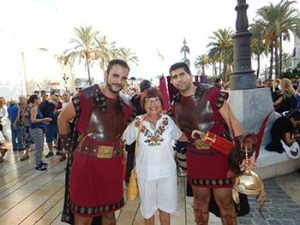 There are many photo ops at these events. Arriving early affords you an opportunity to wander among the participants as they prepare for the parade. They are only too are happy to pose for you, or with you, as they proudly show off their costumes. It is easy to get caught up in the excitement. I stare in awe at the ultimate gladiator sandals gracing the tanned feet of a well-toned gladiator. Now, where can I get a pair like that?
There are many photo ops at these events. Arriving early affords you an opportunity to wander among the participants as they prepare for the parade. They are only too are happy to pose for you, or with you, as they proudly show off their costumes. It is easy to get caught up in the excitement. I stare in awe at the ultimate gladiator sandals gracing the tanned feet of a well-toned gladiator. Now, where can I get a pair like that?
The ambience makes me feel part of history as it is brought to life.
If You Go:
Cartagena is located on the Mediterranean coast in south-eastern Spain.
Alicante International Airport is 116 kilometers from Cartagena.
The closest airport is Murcia’s San Javier airport, 30 kilometers from Cartagena.
There are no direct buses to Cartagena from the San Javier airport; many hire a car at the airport and drive the 20 minutes into town. A taxi costs around €40.
Once there, inexpensive tour buses are available to take you to see the many historic sites of the city. There are also boat tours of the harbour. It is also a great city to explore by foot.
Check the website for the dates and schedule of the Romans and Carthaginians Festival held at the end of September every year.
About the author:
Darlene Foster is a dedicated writer and traveler. She is the author of a series of books featuring Amanda, a spunky young girl who loves to travel to interesting places such as the United Arab Emirates, Spain, England, Alberta and Eastern Europe, where she always has an exciting adventure. Darlene divides her time between the west coast of Canada and the Costa Blanca of Spain when she isn’t exploring the world. Visit darlenefoster.ca.
All photos by Darlene Foster



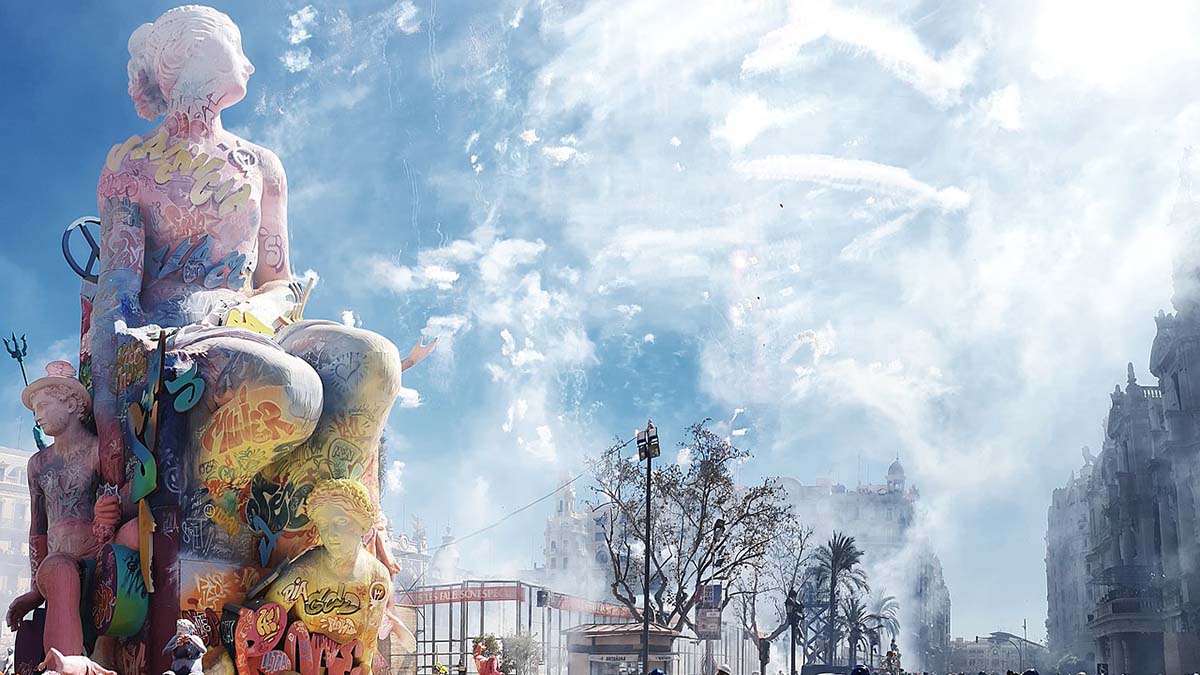

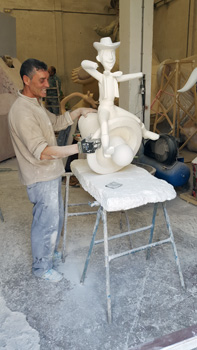 Those simple early ninots have evolved into magnificent wax and polystrene figurines that require such precise skills that the artists who create them now have their own guild, The Guild of Falleros Artists; at least two schools who specialize in training them; two museums dedicated to their work and a part of Valencia known as Cuidad del Artisto Fallera (the City of Falleros Artists) where many of them have full-time workshops.
Those simple early ninots have evolved into magnificent wax and polystrene figurines that require such precise skills that the artists who create them now have their own guild, The Guild of Falleros Artists; at least two schools who specialize in training them; two museums dedicated to their work and a part of Valencia known as Cuidad del Artisto Fallera (the City of Falleros Artists) where many of them have full-time workshops.
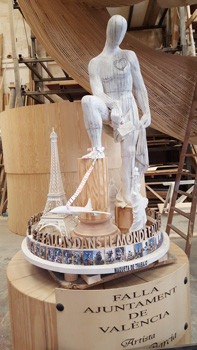 The scale model and the massive pieces of the scene in the workshop did not do justice to the full scale of the monument as it was being constructed. Because of its sheer size, much of the actual carpentry happened in the plaza where the public could watch its daily progress. The monument, called Fallas of the World, consisted of a tall wooden human figure surrounded by world “monuments” that had been part of previous years’ fallas structures – the EIffel Tower, the Statue of Liberty, the Concorde jet, the statues of David and Moses.
The scale model and the massive pieces of the scene in the workshop did not do justice to the full scale of the monument as it was being constructed. Because of its sheer size, much of the actual carpentry happened in the plaza where the public could watch its daily progress. The monument, called Fallas of the World, consisted of a tall wooden human figure surrounded by world “monuments” that had been part of previous years’ fallas structures – the EIffel Tower, the Statue of Liberty, the Concorde jet, the statues of David and Moses.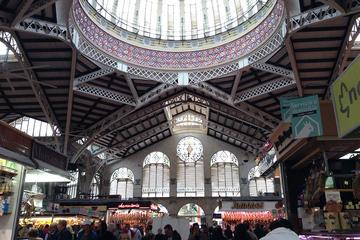

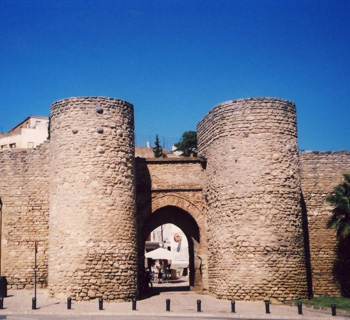
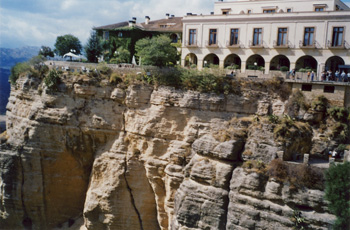 The sun is just setting behind the Serranía de Ronda (Ronda Mountain Range) and an hour and a half later, we arrive, relieved and unscathed.
The sun is just setting behind the Serranía de Ronda (Ronda Mountain Range) and an hour and a half later, we arrive, relieved and unscathed.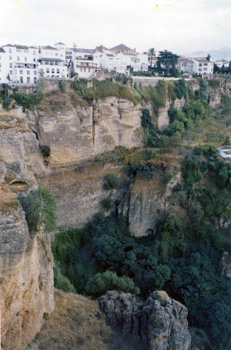 Ronda is one of the oldest cities in Spain first settled by the Celts around the 10th century BCE as Arunda. The town continued to thrive under the Romans as did the nearby settlement of Acinipo originally founded by the Phoenicians. Today, ruins of a vast Roman theatre and thermal baths dated to the 1st century can be visited about 12 miles northwest from Ronda in the ancient city of Acinipo or, as it is locally known, Ronda La Vieja (Old Ronda.)
Ronda is one of the oldest cities in Spain first settled by the Celts around the 10th century BCE as Arunda. The town continued to thrive under the Romans as did the nearby settlement of Acinipo originally founded by the Phoenicians. Today, ruins of a vast Roman theatre and thermal baths dated to the 1st century can be visited about 12 miles northwest from Ronda in the ancient city of Acinipo or, as it is locally known, Ronda La Vieja (Old Ronda.)
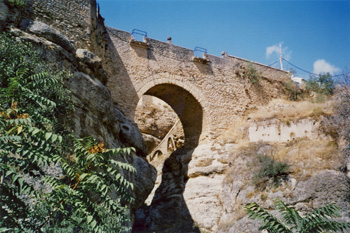 Ronda is the birthplace of the highly gifted 9th century Muslim Andalusí physician, mathematician, and engineer known as Abbas ibn Firnas. Of Berber descent, Firnas was also an illustrious inventor creating such ingenious devices as a water clock, a mechanized planetarium, an armillary sphere, and even a flying machine (for this reason, he is known as the “father of aviation.”) Firnas was also skilled in astronomy, music, and poetry as well as being responsible for introducing glass-making techniques to al-Andalus (Andalusia during Muslim Spain.) Today, he has an airport in northern Baghdad and a lunar crater named in his honour as well as a bridge in Córdoba where he died in 887.
Ronda is the birthplace of the highly gifted 9th century Muslim Andalusí physician, mathematician, and engineer known as Abbas ibn Firnas. Of Berber descent, Firnas was also an illustrious inventor creating such ingenious devices as a water clock, a mechanized planetarium, an armillary sphere, and even a flying machine (for this reason, he is known as the “father of aviation.”) Firnas was also skilled in astronomy, music, and poetry as well as being responsible for introducing glass-making techniques to al-Andalus (Andalusia during Muslim Spain.) Today, he has an airport in northern Baghdad and a lunar crater named in his honour as well as a bridge in Córdoba where he died in 887.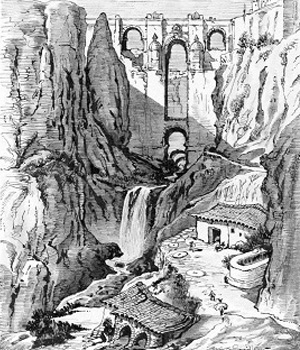 The town of Ronda is connected by three bridges that cross the deep canyon adding to the city’s remarkable features. The Roman Bridge is the oldest dating to the 11th century. Although it is Arabic in origin, it was likely constructed over an older Roman bridge. After the Christian conquest it was renamed Puente de San Miguel (St. Michaels Bridge.) Not far away is the early 17th century Puente Viejo (Old Bridge) and smallest of the three. As it was built over the ruins of an old Arab bridge, it is also known as Puente Árabe.
The town of Ronda is connected by three bridges that cross the deep canyon adding to the city’s remarkable features. The Roman Bridge is the oldest dating to the 11th century. Although it is Arabic in origin, it was likely constructed over an older Roman bridge. After the Christian conquest it was renamed Puente de San Miguel (St. Michaels Bridge.) Not far away is the early 17th century Puente Viejo (Old Bridge) and smallest of the three. As it was built over the ruins of an old Arab bridge, it is also known as Puente Árabe.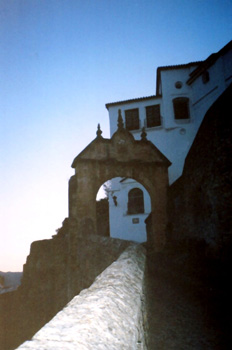 After crossing this bridge, I wander the charming old Moorish quarter with its winding pedestrian streets, white-washed houses, and historic squares. Locally known as La Ciudad (The City), the old quarter is situated on the south side of the gorge as opposed to the newer city on the north. Not for from Puente Nuevo in the historic quarter is an interesting gate known as Arco de Felipe V (Arch of Philip V.) This emblematic arch or gate, crowned by three pinnacles, was reconstructed in 1742 from the old Arab gate that provided access to the medina by the southwest.
After crossing this bridge, I wander the charming old Moorish quarter with its winding pedestrian streets, white-washed houses, and historic squares. Locally known as La Ciudad (The City), the old quarter is situated on the south side of the gorge as opposed to the newer city on the north. Not for from Puente Nuevo in the historic quarter is an interesting gate known as Arco de Felipe V (Arch of Philip V.) This emblematic arch or gate, crowned by three pinnacles, was reconstructed in 1742 from the old Arab gate that provided access to the medina by the southwest.
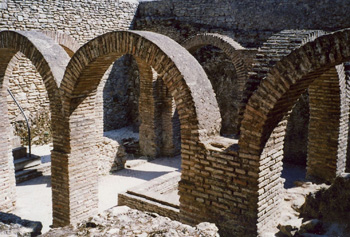 Next I decide to visit the 14th century Alminar (minaret) of San Sebastián in the old Moorish quarter. The impressive square tower is all that remains of a mosque that once stood here before it was destroyed and rebuilt by the Christians. The lower part is clearly Moorish in architecture while the top part was added by the Christians to house the bell tower of the San Sebastián Church that also once stood here.
Next I decide to visit the 14th century Alminar (minaret) of San Sebastián in the old Moorish quarter. The impressive square tower is all that remains of a mosque that once stood here before it was destroyed and rebuilt by the Christians. The lower part is clearly Moorish in architecture while the top part was added by the Christians to house the bell tower of the San Sebastián Church that also once stood here.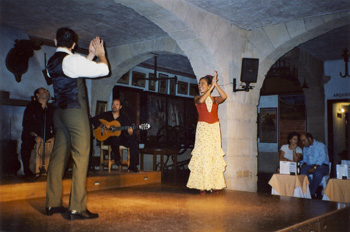 Near the minaret is the early 14th century Casa de Mondagrón that is also well worth visiting. The stone palace, promoted as “probably the most important civil monument in Ronda”, was the former residence of a king and its last Muslim governor. In 1485, Ronda was captured by the Christians and a few years later, King Fernando and Queen Isabella also made this palace their home. Although restored and enlarged during the 18th century, the exterior pales in comparison to the beauty of its interior adorned with arched patios, ceramic tiles, marble columns, balconies overlooking at inner courtyards, decorated fountains and water gardens. Today it also houses an auditorium and a municipal museum on the second floor.
Near the minaret is the early 14th century Casa de Mondagrón that is also well worth visiting. The stone palace, promoted as “probably the most important civil monument in Ronda”, was the former residence of a king and its last Muslim governor. In 1485, Ronda was captured by the Christians and a few years later, King Fernando and Queen Isabella also made this palace their home. Although restored and enlarged during the 18th century, the exterior pales in comparison to the beauty of its interior adorned with arched patios, ceramic tiles, marble columns, balconies overlooking at inner courtyards, decorated fountains and water gardens. Today it also houses an auditorium and a municipal museum on the second floor. Ronda is also the birthplace of bullfighting. Not only was the first professional bullfighter born here in 1754 but it is also home of the oldest and largest bullfighting ring in the country dated to 1785. Another unique and unusual aspect of Ronda is their fascination with bandoleros (bandits); particularly those between the 18th and 19th centuries.
Ronda is also the birthplace of bullfighting. Not only was the first professional bullfighter born here in 1754 but it is also home of the oldest and largest bullfighting ring in the country dated to 1785. Another unique and unusual aspect of Ronda is their fascination with bandoleros (bandits); particularly those between the 18th and 19th centuries.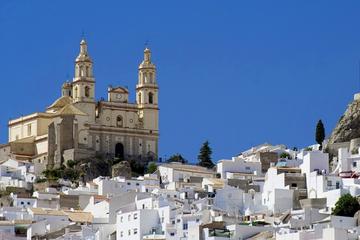

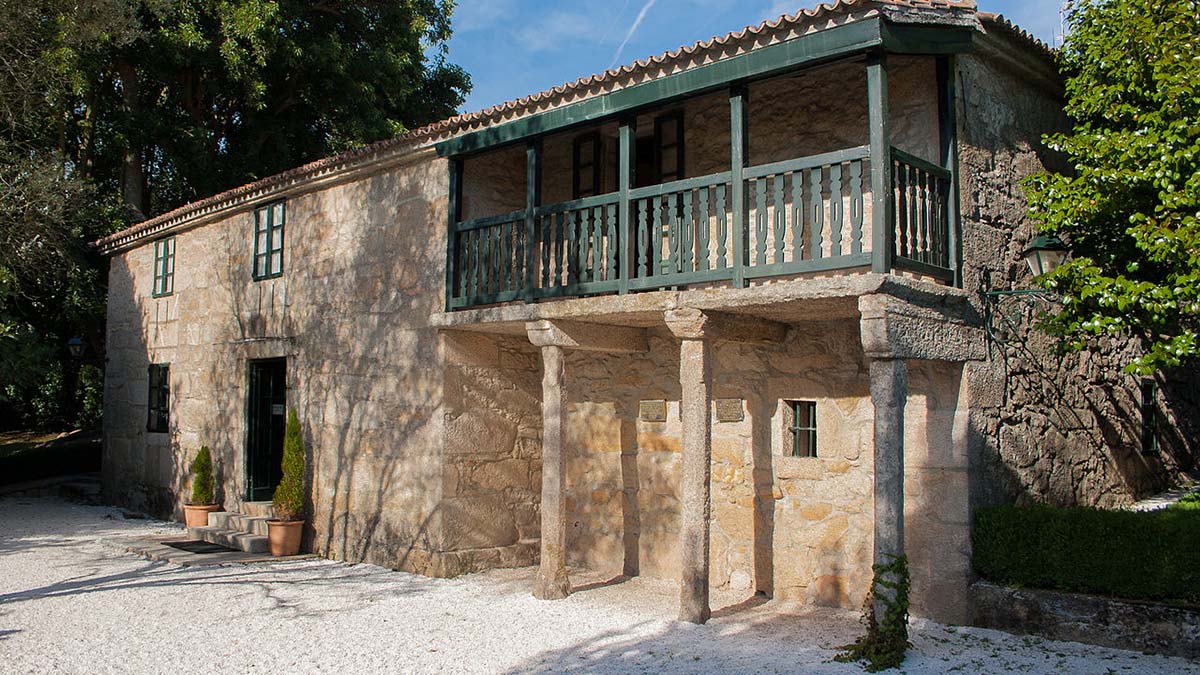
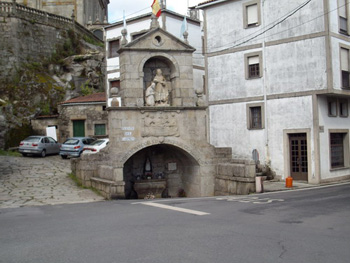 Before I set off on my three week trip to Galicia, Spain’s green, wet and wild northern province, I had a vague idea who Rosalia de Castro was, but none whatsoever about a place called Padron.
Before I set off on my three week trip to Galicia, Spain’s green, wet and wild northern province, I had a vague idea who Rosalia de Castro was, but none whatsoever about a place called Padron.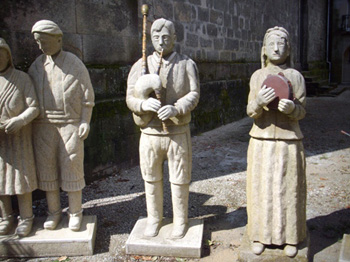 Still, my main interest was Rosalia de Castro. Even before I went to Galicia, I was familiar with the idiosyncratic concept of moriña. It’s best translated as a deeply felt longing of every Galego for his home and roots. An example: a Galego who has to move to – say – Madrid, considers himself an ex-pat. Another word for moriña is saludade and that’s also the Leitmotiv of Rosalia’s work.
Still, my main interest was Rosalia de Castro. Even before I went to Galicia, I was familiar with the idiosyncratic concept of moriña. It’s best translated as a deeply felt longing of every Galego for his home and roots. An example: a Galego who has to move to – say – Madrid, considers himself an ex-pat. Another word for moriña is saludade and that’s also the Leitmotiv of Rosalia’s work.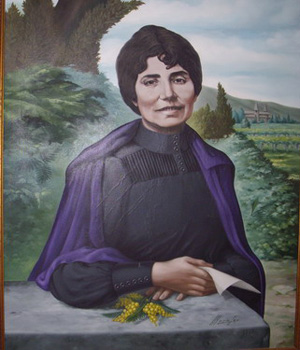 Moreover, although basically a romantic, she strongly opposed abuse of authority and was a strong defender of women’s rights. And she made her voice heard. Married to Manuel Murgia, a historian, academic and journalist, she had seven children despite a very fragile health. She died at age 48 in 1885 in her home in Padron.
Moreover, although basically a romantic, she strongly opposed abuse of authority and was a strong defender of women’s rights. And she made her voice heard. Married to Manuel Murgia, a historian, academic and journalist, she had seven children despite a very fragile health. She died at age 48 in 1885 in her home in Padron.
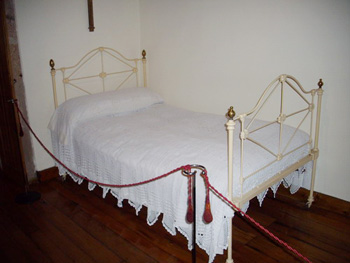 The stone cottage is visible, but only just, above the garden full of trees and flowers which Rosalia tended herself. She used to sit among blooming camellia bushes on a carved stone bench and dream up new poems. The whole scene is so romantic that one feels like writing a love poem there and then.
The stone cottage is visible, but only just, above the garden full of trees and flowers which Rosalia tended herself. She used to sit among blooming camellia bushes on a carved stone bench and dream up new poems. The whole scene is so romantic that one feels like writing a love poem there and then.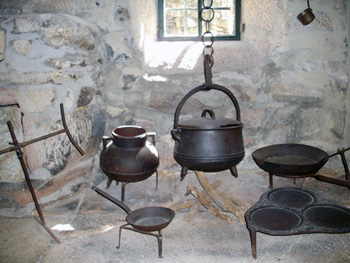 The kitchen with its woodstove and iron kettles looks no different to any other farmhouse kitchen at the time. Her bedroom is spartan, still with her clothes hanging in the closet. Next door is her study with the desk and writing utensils. I wished I could just have sat down, hoping to be infused by her creative spirit.
The kitchen with its woodstove and iron kettles looks no different to any other farmhouse kitchen at the time. Her bedroom is spartan, still with her clothes hanging in the closet. Next door is her study with the desk and writing utensils. I wished I could just have sat down, hoping to be infused by her creative spirit.
